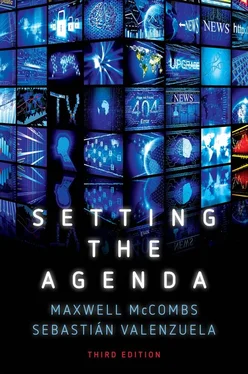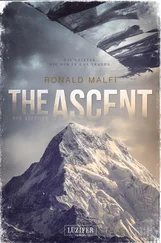In recent years, researchers have examined the agenda-setting effect of the news media outside of the lab, using field experiments. The advantage, in this case, is that the strong internal validity of the experimental design is matched with an equally strong level of external validity, for the results are measured in the real-world beyond the lab. The most well-known of these experiments was carried out by Gary King and his associates at Harvard University. 38After three years of negotiations, he and his colleagues were able to recruit several news organizations to participate in the experiment, including well-known publications like The Nation and Huffington Post . Then, for a year and a half, between two and five of these outlets, in different combinations each time, volunteered to write simultaneous stories on one of eleven broad subjects, such as immigration, climate, and education. Each cluster of stories ran on these outlets in one of two consecutive weeks. The influence of these stories was measured by comparing outcomes in the ‘treatment’ week in which the cluster of stories ran with the ‘control’ week in which the cluster did not run. Each time they carried out this procedure, the researchers conducted an automated content analysis of Twitter chatter. Examination of the discussion of the chosen subject on Twitter found that there was more than a 60 per cent increase in the week after the stories ran. In his commentary on the experiment in Science, Matthew Gentzkow concluded that this study ‘provides one of the most rigorous and convincing data points to date on the agenda-setting power of media’. 39
While experiments are sometimes criticized as artificial situations, they provide vital complementary evidence for the agenda-setting role of the news media. A complete set of evidence for agenda-setting effects requires both the internal validity of experiments where the media and public agendas are tightly controlled and measured and the external validity of content analysis and survey research whose designs assure us that the findings can be generalized beyond the immediate observations at hand to larger settings in the real world. From both streams of evidence, a major contribution of agenda-setting theory is that it makes an explicit connection between specific media content and its effects among the public.
A new communication landscape
With the vast expansion of communication channels in recent decades, particularly the continuing proliferation of internet sites and personalized social media, we have entered a new era of agenda-setting research that is seeking answers to three key research questions.
1. Do online media have agenda-setting effects among the public?
For most of the 1990s and 2000s, attention to the agenda-setting effects of online media centred on how news websites, blogs, bulletin boards, candidate websites, and search engines influenced – or were influenced by – traditional media, a phenomenon commonly referred to as ‘intermedia agenda setting’. In general, the evidence showed a two-way relationship between mainstream media and online media, where both agendas mutually reinforced each other. 40With the arrival of social media platforms and new partisan outlets in the mid 2000s, these initial findings about the reciprocity of issue agendas largely replicated. 41
In comparison to intermedia agenda-setting, fewer studies have documented the effect of online media agendas on the public agenda. Nevertheless, an initial overview of this research found strong support to the basic agenda-setting hypothesis. 42For example, an analysis of candidate websites during the 2010 US Senate election found they were successful at influencing the salience of seven issues among Indianapolis voters. 43Turning to online news media, the increased salience for an array of national issues among viewers of CNN online and for foreign affairs among participants in an experiment who viewed the New York Times online were noted above. 44In South Korea, two alternative online news services, OhmyNews and PRESSian influenced the salience among the public of the deaths of two schoolgirls by a US military vehicle, an issue that resulted in massive anti-US protests. 45The homogeneity of issue agendas between online and traditional media certainly contributes to the strong influence of digital channels on the public’s priorities, a topic that we will discuss shortly. 46
With the rise of social media over the last decades, researchers have focused on the role played by platforms such as Facebook and Twitter on influencing the public agenda. A study conducted in Spain examined whether news consumption through Facebook was associated with having an individualized agenda that diverged from the aggregated public agenda of most important problems. 47By combining survey and web-tracking data, the authors found that the more an individual uses Facebook as a gateway for news, the less likely she will mention the top two issues in the public agenda, which at the time were unemployment and corruption. While statistically significant, the effect was small. Specifically, those who did not use Facebook for news had a 47 per cent probability of mentioning unemployment or corruption as the most important issues. This probability decreased to 35 per cent for the average Facebook user. Nevertheless, when compared to the total list of important issues mentioned by survey respondents, the influence of Facebook was not statistically significant.
Another study 48analysed the reciprocal influence of tweets sent over two years by 36 news media and different random samples of users in the United States. First, the correlation in issue attention between media outlets and the different groups of users (namely, ‘attentive’ public, general public, Democratic supporters, and Republican supporters) varied from +0.55 to +0.79. These correlations suggest moderate to strong relationships between issues agendas. Second, and most importantly, the time-series analyses allowed to establish whether these correlations stem from the ability of the media to set the public agenda on Twitter, or, conversely, resulted from public discussions influencing the subsequent news agenda. The results were rather consistent:
Notably, in each case, the power of shifts in media attention to predict subsequent shifts in attention among all audiences is greater than the reverse, confirming that media outlets play a crucial role in leading political attention. 49
In general, then, the available studies confirm that the transfer of salience from the media agenda to the public agenda takes place not only with traditional news outlets, but also with new interactive, digital platforms. 50That is, when people use media, the potential of that media’s content to set the agenda of public concerns remains.
2. Has the proliferation of online media diminished the agenda-setting impact of the traditional media?
With the transformation of the communication landscape in recent decades – first cable television and subsequently satellite television among the traditional mass media and now the proliferation of websites and personalized social media – some observers have predicted the diminution, if not the disappearance, of agenda-setting effects on the scale that we have observed them over the past half century. 51The argument is that the myriad content choices brought upon by interactive media has increased the competition for people’s attention, thus challenging the place of traditional news in people’s media diet. 52Despite the popularity of this possibility, the overwhelming preponderance of the evidence to date suggests that the agenda-setting role of the media endures. To paraphrase Mark Twain’s famous cable to the Associated Press, reports of agenda setting’s death are greatly exaggerated.
Читать дальше












